The Crucial m4 (Micron C400) SSD Review
by Anand Lal Shimpi on March 31, 2011 3:16 AM ESTLast week I was in Orlando attending CTIA. While enjoying the Florida weather, two SSDs arrived at my office back in NC: Intel's SSD 320, which we just reviewed three days ago and Crucial's m4. Many of you noticed that I had snuck in m4 results in our 320 review but I saved any analysis/conclusions about the drive for its own review.
There are more drives that I've been testing that are missing their own full reviews. Corsair's Performance Series 3 has been in the lab for weeks now, as has Samsung's SSD 470. I'll be talking about both of those in greater detail in an upcoming article as well.
And for those of you asking about my thoughts on the recent OCZ related stuff that has been making the rounds, expect to see all of that addressed in our review of the final Vertex 3. OCZ missed its original March release timeframe for the Vertex 3 in order to fix some last minute bugs with a new firmware revision, so we should be seeing drives hit the market shortly.
There's a lot happening in the SSD space right now. All of the high end manufacturers have put forward their next-generation controllers. With all of the cards on the table it's clear that SandForce is the performance winner once again this round. So far nothing has been able to beat the SF-2200, although some came close—particularly if you're still using a 3Gbps SATA controller.
All isn't lost for competing drives however. While SandForce may be the unequivocal performance leader, compatibility and reliability are both unknowns. SandForce is still a very small company with limited resources. Although validation has apparently improved tremendously since the SF-1200 last year, it takes a while to develop a proven track record. As a result, some users and corporations feel more comfortable buying from non-SF based competitors—although the SF-2200 may do a lot to change some minds once it starts shipping.
The balance of price, performance and reliability is what keeps this market interesting. Do you potentially sacrifice reliability for performance? Or give up some performance for reliability? Or give up one for price? It's even tougher to decide when you take into account that all of the players involved have had major firmware bugs. Even though Intel appears to have the lowest return rate out of all of the drives it's not excluded from the reliability/compatibility debate.
Crucial's m4, Micron's C400
Micron and Intel have a joint venture, IMFT, that produces NAND Flash for both companies as well as their customers. Micron gets 51% of IMFT production for its own use and resale, while Intel gets the remaining 49%.
Micron is mostly a chip and OEM brand, Crucial is its consumer memory/storage arm. Both divisions shipped an SSD called the C300 last year. It was the first 6Gbps SATA SSD we tested and while it posted some great numbers, the drive launched to a very bumpy start.
| Crucial's m4 Lineup | ||||||||||||||
| CT064M4SSD2 | CT128M4SSD2 | CT256M4SSD2 | CT512M4SSD2 | |||||||||||
| User Capacity | 59.6GiB | 119.2GiB | 238.4GiB | 476.8GiB | ||||||||||
| Random Read Performance | 40K IOPS | 40K IOPS | 40K IOPS | 40K IOPS | ||||||||||
| Random Write Performance | 20K IOPS | 35K IOPS | 50K IOPS | 50K IOPS | ||||||||||
| Sequential Read Performance | Up to 415MB/s | Up to 415MB/s | Up to 415MB/s | Up to 415MB/s | ||||||||||
| Sequential Write Performance | Up to 95MB/s | Up to 175MB/s | Up to 260MB/s | Up to 260MB/s | ||||||||||
A few firmware revisions later and the C300 was finally looking good from a reliability perspective. Although recently I have heard reports of performance issues with the latest 006 firmware, the drive has been working well for me thus far. It just goes to show you that company size alone isn't an indication of compatibility and reliability.
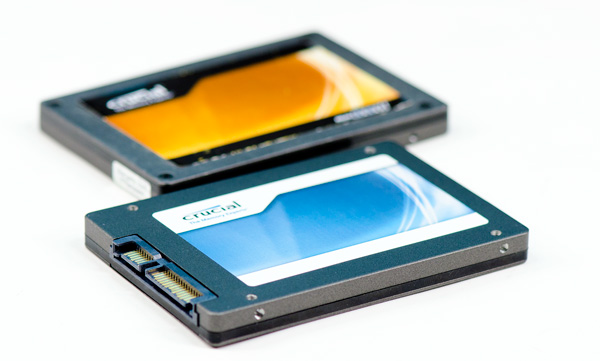
Crucial RealSSD C300 (back), Crucial m4 (front)
This time around Crucial wanted to differentiate its product from what was sold to OEMs. Drives sold by Micron will be branded C400 while consumer drives are called the m4. The two are the same, just with different names.
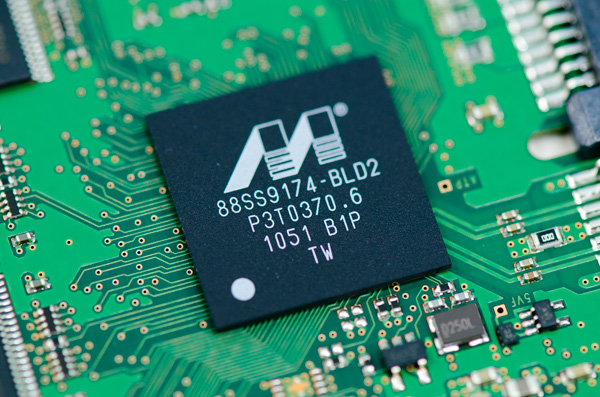
The Marvell 88SS9174-BLD2 in Crucial's m4
Under the hood, er, chassis we have virtually the same controller as the C300. The m4 uses an updated revision of the Marvell 9174 (BLD2 vs. BKK2). Crucial wouldn't go into details as to what was changed, just to say that there were no major architectural differences and it's just an evolution of the same controller used in the C300. When we get to the performance you'll see that Crucial's explanation carries weight. Performance isn't dramatically different from the C300, instead it looks like Crucial played around a bit with firmware. I do wonder if the new revision of the controller is at all less problematic than what was used in the C300. Granted fixing any old problems isn't a guarantee that new ones won't crop up either.
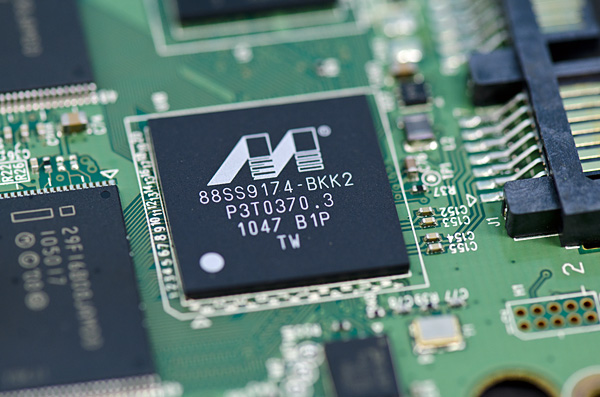
The 88SS9174-BKK2 is in the Intel SSD 510
The m4 is still an 8-channel design. Crucial believes it's important to hit capacities in multiples of 8 (64, 128, 256, 512GB). Crucial also told me that the m4's peak performance isn't limited by the number of channels branching off of the controller so the decision was easy. I am curious to understand why Intel seems to be the only manufacturer that has settled on a 10-channel configuration for its controller while everyone else picked 8-channels.
Crucial sent along a 256GB drive populated with sixteen 16GB 25nm Micron NAND devices. Micron rates its 25nm NAND at 3000 program/erase cycles. By comparison Intel's NAND, coming out of the same fab, is apparently rated at 5000 program/erase cycles. I asked Micron why there's a discrepancy and was told that the silicon's quality and reliability is fundamentally the same. It sounds like the only difference is in testing and validation methodology. In either case I've heard that most 25nm NAND can well exceed its rated program/erase cycles so it's a non-issue.
Furthermore, as we've demonstrated in the past, given a normal desktop usage model even NAND rated for only 3000 program/erase cycles will last for a very long time given a controller with good wear leveling.
Let's quickly do the math again. If you have a 100GB drive and you write 7GB per day you'll program every MLC NAND cell in the drive in just over 14 days—that's one cycle out of three thousand. Outside of SandForce controllers, most SSD controllers will have a write amplification factor greater than 1 in any workload. If we assume a constant write amplification of 20x (and perfect wear leveling) we're still talking about a useful NAND lifespan of almost 6 years. In practice, write amplification for desktop workloads is significantly lower than that.
Remember that the JEDEC spec states that once you've used up all of your rated program/erase cycles, the NAND has to keep your data safe for a year. So even in the unlikely event that you burn through all 3000 p/e cycles and let's assume for a moment that you have some uncharacteristically bad NAND that doesn't last for even one cycle beyond its rating, you should have a full year's worth of data retention left on the drive. By 2013 I'd conservatively estimate NAND to be priced at ~$0.92 per GB and in another three years beyond that you can expect high speed storage to be even cheaper. In short, combined with good ECC and an intelligent controller I wouldn't expect NAND longevity to be a concern at 25nm.
The m4 is currently scheduled for public availability on April 26 (coincidentally the same day I founded AnandTech fourteen years ago), pricing is still TBD. Back at CES Micron gave me a rough indication of pricing however I'm not sure if those prices are higher or lower than what the m4 will ship at. Owning part of a NAND fab obviously gives Micron pricing flexibility, however it also needs to maintain very high profit margins in order to keep said fab up and running (and investors happy).
The Test
| CPU |
Intel Core i7 965 running at 3.2GHz (Turbo & EIST Disabled) Intel Core i7 2600K running at 3.4GHz (Turbo & EIST Disabled)—for AT SB 2011, AS SSD & ATTO |
| Motherboard: |
Intel DX58SO (Intel X58) Intel H67 Motherboard |
| Chipset: |
Intel X58 + Marvell SATA 6Gbps PCIe Intel H67 |
| Chipset Drivers: |
Intel 9.1.1.1015 + Intel IMSM 8.9 Intel 9.1.1.1015 + Intel RST 10.2 |
| Memory: | Qimonda DDR3-1333 4 x 1GB (7-7-7-20) |
| Video Card: | eVGA GeForce GTX 285 |
| Video Drivers: | NVIDIA ForceWare 190.38 64-bit |
| Desktop Resolution: | 1920 x 1200 |
| OS: | Windows 7 x64 |


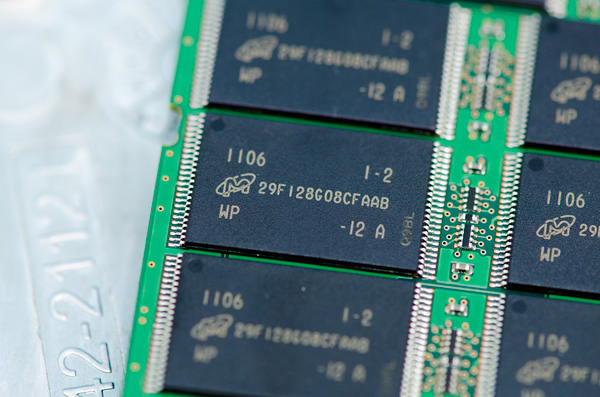
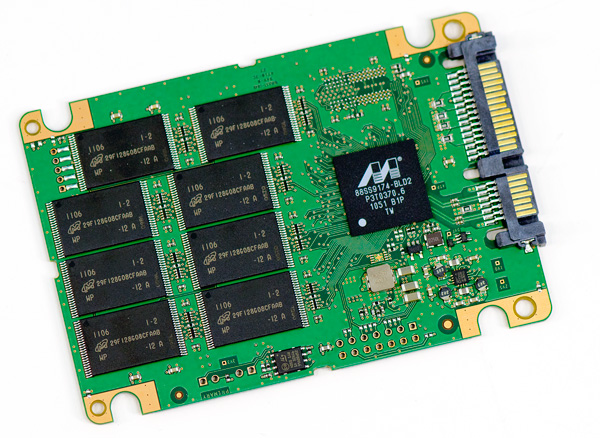
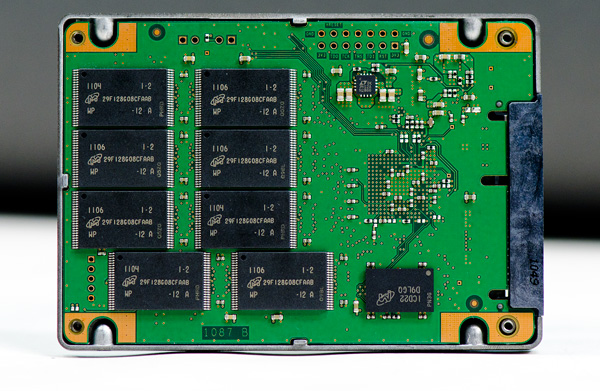








103 Comments
View All Comments
JNo - Thursday, March 31, 2011 - link
On another note, now that my system drive is an 80GB Intel X25M SSD, I really notice how my Documents folders that all have to be on mechanical HDDs due to their size, are very unresponsive. In fact often Win 7 hangs for about 10-15 secs just trying to open my Documents or Video folder when nothing else is going on! (This on a Core2 Q6600 so not a netbook or anything).Whilst I'm sure I would benefit from a 6Gbs controller and a Vertex 3 or m4, I wonder if the smart money in future will go on getting one or two cheap(er!) 40GB SSDs to act as cache drives for my couple of larger (1 - 2 TB) media and Documents drives. The figures on Tomshardware on Z68 caching performance were not awe inspiring but definitely a great option to have...
james.jwb - Thursday, March 31, 2011 - link
The HDD is probably going into sleep mode. Happens to mine all the time with an SSD. I hear it spin up as my PC is silent apart from the HDD. Could always turn it off or prolong it kicking in.strikeback03 - Thursday, March 31, 2011 - link
Seconded, I hear the same thing on my Win7 desktop with an 80GB X25M G2 and 3 mechanical HDDs. The HDDs go to sleep after 15-30 min, and take several seconds to spin back up when data is needed. It isn't enough of a bother to me to change the sleep time, but it can be done if necessary.softdrinkviking - Thursday, March 31, 2011 - link
Anand,you've already seen the results of the new samsung drive, and the new corsair, and who knows how many other SSDs are currently being pu tthrough the paces in your lab.
those drives that are still officially unknown paint a more complete picture of the industry and the future of SSDs.
how much would you say your reviews reflect that bigger picture?
are we to assume that you are giving us your opinion of this drive from our perspective, or yours?
I know that can be a hard balance to strike in writing, between the prescient and the contemporaneous, and I can't help but wonder.
Anand Lal Shimpi - Thursday, March 31, 2011 - link
I'd say the majority of what you see here is reflecting the bigger picture. The Corsair P3 is nice but it seems to fall behind Intel's 510. The Samsung 470 is a great 3Gbps offering but it's a bit pricey. I still have some additional testing to do on both of those, which I expect to be done (realistically) next week.Take care,
Anand
Lonesloane - Thursday, March 31, 2011 - link
I'm really missing "real world benchmarks", such as loading times. These synthetical benchmarks mean nothing to me.In general it seems as Sandforce will be the big winner of the SSD market in 2011.
Anand Lal Shimpi - Thursday, March 31, 2011 - link
Load times for a single application are pretty much consistant through all of the modern SSDs. It's really in the heavy workload scenarios or periods of burst activity that you'll see differences. Note that our own storage bench suite plays back real world IO tasks that encompass exactly what you're looking for :)Take care,
Anand
sticks435 - Thursday, March 31, 2011 - link
One thing I'd like to see is the Vantage scores on a Sandy Bridge platform. Since most other sites use it as their real world benchmark, and they/most users will probably be using these new drives with a SB system, it makes it a little easier to compare numbers. Yes, I know comparing from site to site is usually a crap shoot, but would still be a nice to have. Perhaps when PC Mark 7 is available.shatteredx - Thursday, March 31, 2011 - link
For many of us, SSD performance has reached the "good enough" milestone. The "big winner" of the SSD in market in 2011 will be whoever is willing to price these things the cheapest combined with typical customer feedback that the drives are reliable.Anand's prediction that we'll have to wait until 2014 for prices to drop under $1/GB is not comforting.
geniekid - Thursday, March 31, 2011 - link
++. In fact, I thought SSDs were good enough two years ago. Give me one of these new SSDs with HALF the performance and twice the storage size at the same price and I'll take it.